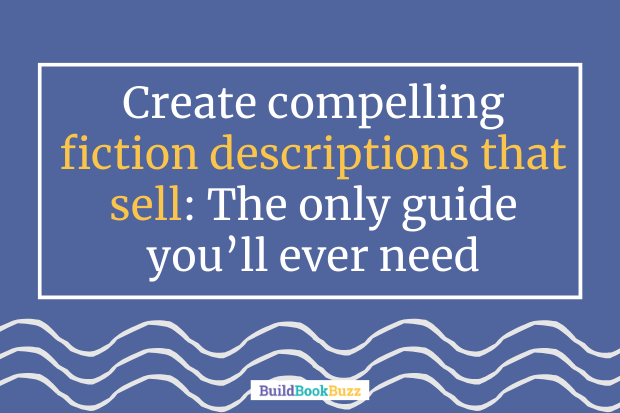Create compelling fiction descriptions that sell: The only guide you’ll ever need
Novelists understand the importance of fiction descriptions that sell books. But do you know how to write one? Read this book and you will.
Affiliate Disclosure: This post contains Amazon Associates links, which means if you click on them and make a purchase, I will receive a couple of pennies (at no extra charge to you).
A compelling book description is such an important book marketing building block that one of the first things I do when coaching a novelist is read their book description.
I can tell quickly if it works or not. I’m able to offer high-level feedback on why it doesn’t – maybe the writing itself is weak or awkward.
Perhaps it doesn’t tell me enough to interest me. More commonly, though, it tells me too much.
What I haven’t been able to do, though, is offer specific feedback on how to improve it.
This book has completely changed that.
The missing link for writing book descriptions that work
Authored by Phoebe Ravencraft, editor-in-chief of book description company Best Page Forward, “Fiction Blurbs The Best Page Forward Way: The Step-by-Step Guide to Win over Readers, Sell More Books, and Market Like a Pro,”* offers specific, detailed instructions for writing a book description that will turn book browsers into book buyers.
Now I can say to a book marketing coaching client:
- “It doesn’t tell me what’s as stake.”
- “The main character has no agency.”
- “You need to bridge from the first paragraph to the second.”
And that’s just for starters.
Sentence-by-sentence breakdown of fiction descriptions that sell
Those of you who have been reading my articles here for a while know that I’m big on how-to information. I know how frustrating it is to be told it’s important that you take a specific action without also having instructions on how to do it.
Ravencraft seems to share that approach. She deconstructs book descriptions at the sentence level so you understand the role each sentence in your description must play. (One related tip from the book: Never use “must” in your description.)
Before and after examples illustrate concepts in ways that underscore what you’ll learn.
What’s covered in the book
I see Ravencraft’s book as a course on how to write fiction descriptions that sell. In this affordable but powerful guide, you’ll learn:
- The elements of a fiction, memoir, or narrative nonfiction book description that sells
- Why those elements are important
- How to write those elements
- Specific words that will make your descriptions more appealing to readers
- How to pull it all together
Every chapter ends with a homework assignment involving books and movies you know well.
Do the homework. It will give you the practice needed to create a book description or improve one you’ve written already.
If you start to get overwhelmed while reading, take a break. Set the book aside and come back to it later – but do come back. It’s important information.
Create a fiction descriptions that sell cheat sheet
I highly (highly!) recommend building on the minimalistic, bare-bones templates in the appendix to create your own cheat sheet.
I love cheat sheets – at-a-glance summaries of the most important details related to a topic. Because of that, as I read this book, I kept wanting to create one with tips for writing each book description element.
For example, under P1S1, the author’s shorthand for “paragraph 1, sentence 1,” I’d add some of her must-includes and must-avoids. Doing this will make an already valuable resource more useful, not only for the description you’re writing now, but for those to come, too.
I don’t write fiction so that’s pointless for me, but it will be a useful exercise for you.
Buy this book
If you’re a self-published novelist, buy “Fiction Blurbs The Best Page Forward Way: The Step-by-Step Guide to Win over Readers, Sell More Books, and Market Like a Pro.”
If you’re a traditionally published author, I want you to buy this book, too. It will help reassure you that your publisher’s description does its job. If it doesn’t, it will give you the tools you need to provide constructive feedback.
*While traditional publishers (and this blog) define “blurb” as an endorsement or testimonial, the author uses it to mean “book description.” This is common usage.
What’s your best top for writing a book description that sells? Please tell us in a comment.
Like what you’re reading? Get it delivered to your inbox every week by subscribing to the free Build Book Buzz newsletter. You’ll also get my free “Top 5 Free Book Promotion Resources” cheat sheet immediately!



I guess this is not very helpful for non-fiction writers sigh…
Correct. But there are other resources for that, including this article: https://kindlepreneur.com/write-a-book-description/
Sandy
I read the free sample in my Kindle library, and was so impressed that I just bought the book. Thanks, Sandy.
I know you’ll like it, Todd!
Sandy